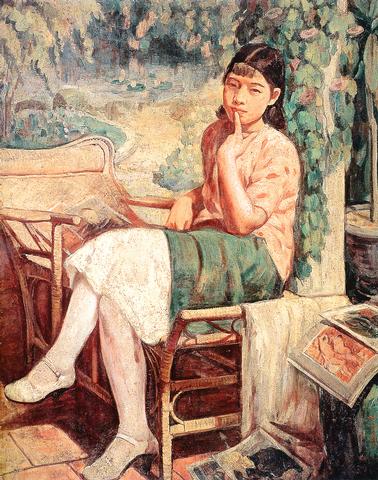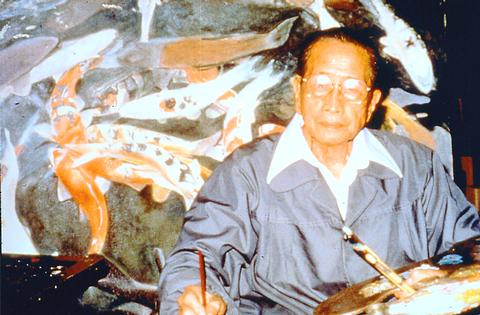The year 1902 was an auspicious one for Taiwanese art, as it is the birth date of three of the country's master painters -- Li Mei-shu
The exhibition showcases 33 of his watercolor and oil paintings on loan from the Li Mei-shu Memorial Gallery
Another eye-catching portrait is that of the artist's first daughter Li Li-hsia

PHOTO COURTESY OF LI MEI-SHU MEMORIAL GALLERY
Many of Li's portraits seem almost photographic in their precision, especially Li's portrait of his third daughter-in-law titled Enjoying the Water (
Li had no shortage of subject matter, with five daughters and three sons and a large extended family. When the show opened May 4, over 70 of Li's children, grandchildren and relatives, including eight women who were subjects of his paintings, were on site at the Palace Museum with President Chen Shui-bian
Li's children have been especially active in the preservation of their father's artistic legacy, opening a gallery in Sanhsia in 1995 with about 500 works, and they were the driving force behind his exhibition.

PHOTO: PALACE MUSEUM
Li's status in art history, however, goes beyond portraits of his family members. He is an earnest realist with a genuine concern for society conveyed through his paintings that show life during the transitional period when Taiwan returned from Japanese rule. One representative piece from this period is At Dusk (黃昏) from 1948. The painting is a heroic depiction of female peasants toiling with their spirit unbroken through hard times and is often compared to Jean Francois Millet's famed piece The Gleaners.
Also featured in the Palace Museum exhibit are beautiful landscape paintings of Sanhsia, Li's hometown. These serve as a fine reminder of an idyllic countryside. Morning Along the River (河邊清晨) and Spring Morning in Sanhsia (三峽春曉) depict scenes of people lingering along the Tamsui River banks in an ode to the land and the people.
As well as being an artist, Li was also an educator, who, between 1963 and 1973 served as dean of the fine arts department at the National Taiwan Institute of Art. He once served as the chairman for his hometown's assembly and then as a Taipei County councilman and was an active force in preserving cultural heritage sites. One major project he participated in was the reconstruction for the Tsu-shih Temple (祖師廟) in Sanhsia, to which he dedicated his energy for almost 40 years until he passed away in 1983.
The Li Mei-shu Memorial Gallery in Sanhsia is open to the public only on Saturday and Sunday from 10am to 4:30pm. Guided tours are also available on weekdays to groups upon reservation. Call 2673-2333 for more information.
Art Notes:
What: Portraits of the Land and People: A Centennial Exhibition in Commemoration of Li Mei-shu (1902-1983) (人親土親:李梅樹百年紀念特展)
Where: Gallery 104, National Palace Museum (故宮博物院104室), 221 Chihshan Rd., Sec. 2, Shihlin, Taipei (士林至善路二段221號)
When: Until Aug. 5

May 26 to June 1 When the Qing Dynasty first took control over many parts of Taiwan in 1684, it roughly continued the Kingdom of Tungning’s administrative borders (see below), setting up one prefecture and three counties. The actual area of control covered today’s Chiayi, Tainan and Kaohsiung. The administrative center was in Taiwan Prefecture, in today’s Tainan. But as Han settlement expanded and due to rebellions and other international incidents, the administrative units became more complex. By the time Taiwan became a province of the Qing in 1887, there were three prefectures, eleven counties, three subprefectures and one directly-administered prefecture, with

It’s an enormous dome of colorful glass, something between the Sistine Chapel and a Marc Chagall fresco. And yet, it’s just a subway station. Formosa Boulevard is the heart of Kaohsiung’s mass transit system. In metro terms, it’s modest: the only transfer station in a network with just two lines. But it’s a landmark nonetheless: a civic space that serves as much more than a point of transit. On a hot Sunday, the corridors and vast halls are filled with a market selling everything from second-hand clothes to toys and house decorations. It’s just one of the many events the station hosts,

Among Thailand’s Chinese Nationalist Party (KMT) villages, a certain rivalry exists between Arunothai, the largest of these villages, and Mae Salong, which is currently the most prosperous. Historically, the rivalry stems from a split in KMT military factions in the early 1960s, which divided command and opium territories after Chiang Kai-shek (蔣介石) cut off open support in 1961 due to international pressure (see part two, “The KMT opium lords of the Golden Triangle,” on May 20). But today this rivalry manifests as a different kind of split, with Arunothai leading a pro-China faction and Mae Salong staunchly aligned to Taiwan.

Two moves show Taichung Mayor Lu Shiow-yen (盧秀燕) is gunning for Chinese Nationalist Party (KMT) party chair and the 2028 presidential election. Technically, these are not yet “officially” official, but by the rules of Taiwan politics, she is now on the dance floor. Earlier this month Lu confirmed in an interview in Japan’s Nikkei that she was considering running for KMT chair. This is not new news, but according to reports from her camp she previously was still considering the case for and against running. By choosing a respected, international news outlet, she declared it to the world. While the outside world